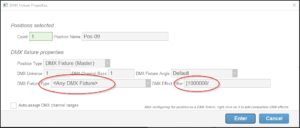As there are tens of thousands of DMX fixtures and uncountably many variations of effects, the concept of a “Standard Fixture ID” or a “Standard Effect ID” may sound improbable, but that doesn’t diminish the value in organizing and categorizing the fixtures and effects that Finale 3D does know about while still allowing users to add their own fixtures and define their own effects for use in Finale 3D with user-defined fixture IDs.
Standard Fixture IDs and Standard Effect IDs make it possible to convert effects from one fixture to another (Fixture cloning). The Standard Fixture IDs also make it possible for the Finale 3D user interface to filter the effect choices that can be added to a fixture according to their compatibility, and to error check at times of addressing and exporting that the show does not contain any incompatibilities.
Standard Fixture IDs are integers in the range 1 – 99 and 200-999999. User-defined fixture IDs are any integers in the range 100-199. To avoid fixture ID conflicts with other users when collaborating, users can request Standard Fixture IDs for their fixtures by emailing Finale support. Finale maintains the registry of Standard Fixture IDs as a simple and free service.
Standard Effect IDs are in the range 0 – 999999. Users can define their own effect IDs arbitrarily if they aren’t concerned with converting those effect definitions between different fixture types. Users can simply use the number “1” for all their user-defined effect IDs, for example. If interested in contributing to the registry of effects that can be converted between fixture types, users can email Finale support to add their effect definitions as Standard Effect IDs.
A list of Standard Fixture IDs for flame and spark fixtures is here. A list of Standard Effect IDs for flame and spark fixtures is here.
Implementation
Figure 1 shows some DMX effects in the effects window that have Standard Effect IDs and Standard Fixture IDs. The IDs are simply an annotation in the effect description, nothing more. They are two numbers, separated by a slash and surrounded by square brackets. The first number is the Standard Fixture ID that the effect is compatible with. The second is the Standard Effect ID that identifies the fixture independent meaning of the effect. For example, many different flame fixtures have the concept of a safety channel effect. Their implementation may be different, as different fixtures place the safety channel at various offsets and require various values or ranges of DMX values to activate the fixture. Despite the difference in implementation, though, the concept of a safety channel is the same for all fixtures, so it makes sense that a safety channel effect can have Standard Fixture ID that means, “safety channel.”
The two underlined effects in Figure 1 have the same effect IDs (0201) but different fixture IDs (003 and 004). These fixture IDs represent two different DMX modes of the MagicFX Flamaniac flamer fixture that have completely different DMX personalities. From Finale 3D‘s perspective, a Mode1 Flamaniac is a different type of fixture from a Mode2 Flamaniac, and each has a set of effects that is compatible with it.
If you design a show with Mode1 Flamaniac fixtures and subsequently decide that you prefer to operate your hardware in Mode2, you can use the Finale 3D function “Change DMX fixture and convert effects…” to convert the show. The Standard Effect IDs and Standard Fixture IDs enable the conversion of the show’s effects with a simple replacement scheme: for each effect in the show with fixture ID 003 in its description, find a replacement with the same effect ID (0201 in this case) and the desired replacement fixture ID 004.

Figure 1 – Standard Fixture IDs and Standard Effect IDs make it possible to convert effects from one fixture to another.
Generic fixtures and user-defined effects
The DMX Fixture Type option of “<Any DMX Fixture>” in the fixture properties dialog makes the fixture compatible with all DMX effects, no matter what fixture IDs are embedded in their description if any at all. Users can create their own DMX effects and add them to fixtures of type “<Any DMX Fixture>” without any issue. The fixture cloning feature is not available for fixtures of this generic type, and the features that automatically assign channel ranges to fixtures are also not available, but there are no other functionality limitations.

Figure 2 – Users can add their own fixture types as “<Any DMX Fixture>” and can use DMX Effect Filter for compatibility filtering.
The filtering of effects by compatibility in the “Add DMX effect to fixture” function is available for user-defined effects by way of the DMX Effect Filter field. When you select a pre-defined fixture type, the DMX Effect Filter fills in automatically with the fixture ID surrounded by bracket and slash. Effects are filtered to effects whose descriptions contain the DMX Effect Filter phrase as a substring. Thus for user-defined effects, you can add your own made-up fixture ID in this field to filter the fixture to a set of effects that you have defined with the same made-up fixture ID. Fixture IDs beginning at 1000000 are reserved for user-defined effects, so if you define your own fixtures IDs as 1000000 or higher, you are guaranteed they will not conflict with pre-defined fixture IDs.